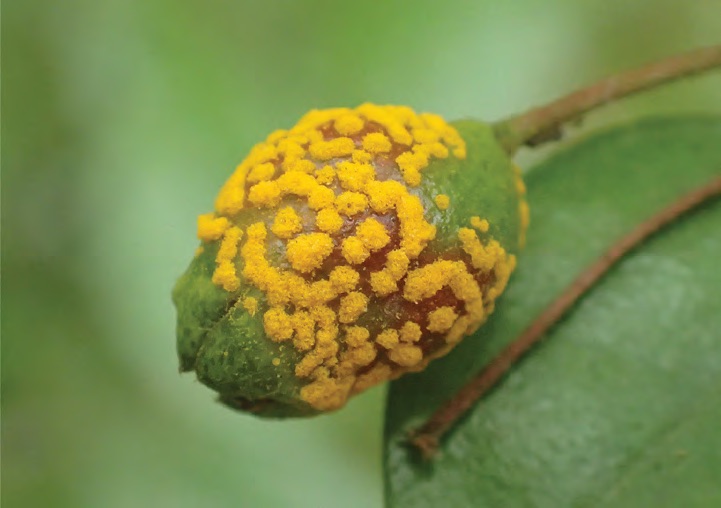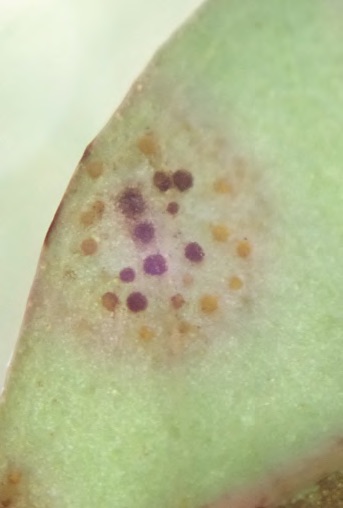PESTS AND DISEASES OF FORESTRY IN NEW ZEALAND
Myrtle rust is having sex – why this matters and what it means for New Zealand
Scion is the leading provider of forest-related knowledge in New Zealand
Formerly known as the Forest Research Institute, Scion has been a leader in research relating to forest health for over 50 years. The Rotorua-based Crown Research Institute continues to provide science that will protect all forests from damage caused by insect pests, pathogens and weeds. The information presented below arises from these research activities.
A study has just been published containing new evidence that Austropuccinia psidii, the fungus that causes myrtle rust, is reproducing sexually in New Zealand in addition to cloning itself. This means that the fungus will have a better chance of adapting to natural plant resistance as well as biological and chemical controls.
Clonal reproduction is a strategy of making identical copies of oneself. The benefits of clonal reproduction are simple: why change what’s working?
“Reproducing clonally means you can have a really successful explosion of clones,” says Stuart Fraser, a researcher from Scion who is one of the authors on the paper, published in the European Journal of Plant Pathology.
However, clonal reproduction does have its limits. Clones that are too successful can wipe out their host, leaving the pathogen with no resources and a limited ability to adapt to a new host. Or, when a clone encounters a resistant individual, it will be unable to infect that host.
“Having sex creates new individuals with new genotypes, allowing the fungus to adapt to host defences,” says Fraser. “Sexual recombination also allows it to adapt to new environments and new host species.”
Although most fungi have a mixed mating system, meaning they can reproduce both clonally and sexually, previous research from other parts of the world have suggested that A. psidii reproduces clonally. However, this new study on samples of A. psidii from New Zealand shows evidence of sexual recombination in addition to cloning.
This evidence is twofold. First, the sexual stage of the fungus was present in the samples. Second, the high genotypic diversity found is best explained by genetic recombination rather than random mutation.


This has important implications for scientists who are working to protect New Zealand’s native myrtles – like pōhutukawa, mānuka and kānuka – from infection by myrtle rust.
“Sexual recombination will allow the pathogen to diversify, increasing the likelihood that it will eventually resist chemicals and control agents,” says Fraser.
This also makes it more likely that the fungus will adapt to resistance in host plants.
“If you find a resistant individual and you cultivate it on a large scale, that’s not the end,” says Fraser. “You have to keep screening for new resistance as the rust changes.”
While it can be easier to manage clonal pathogens, Fraser doesn’t think sexual recombination in A. psidii necessarily spells disaster for efforts to find resistance and to develop controls.
“Sex makes myrtle rust more complicated to manage,” says Fraser. “It is important that we are aware of the impacts of sexual reproduction and plan our research around it.”
The Beyond Myrtle Rust Programme is doing just that. One of their key goals is to improve understanding of A. psidii reproduction in New Zealand. This research area, which is being led by Fraser and Alistair McTaggart, the lead author on the paper, will investigate how sexual recombination is being driven by the environment and by hosts.
“We don’t know the frequency or impact of sexual reproduction in natural populations,” says McTaggart. “However, we hope our research improves knowledge on the biology of myrtle rust and informs strategies for combatting the disease in the future.”
Jenny Leonard Manaaki Whenua - Landcare Research
McTaggart AR, du Plessis E, Roux J, Barnes I, Fraser S, Granados GM, Ho WW, Shuey LS and Drenth A, 2020. Sexual reproduction in populations of Austropuccinia psidii. European Journal of Plant Pathology 156: 537-545.
This information is intended for general interest only. It is not intended to be a substitute for specific specialist advice on any matter and should not be relied on for that purpose. Scion will not be liable for any direct, indirect, incidental, special, consequential or exemplary damages, loss of profits, or any other intangible losses that result from using the information provided on this site.
(Scion is the trading name of the New Zealand Forest Research Institute Limited.)

 Farm Forestry New Zealand
Farm Forestry New Zealand

